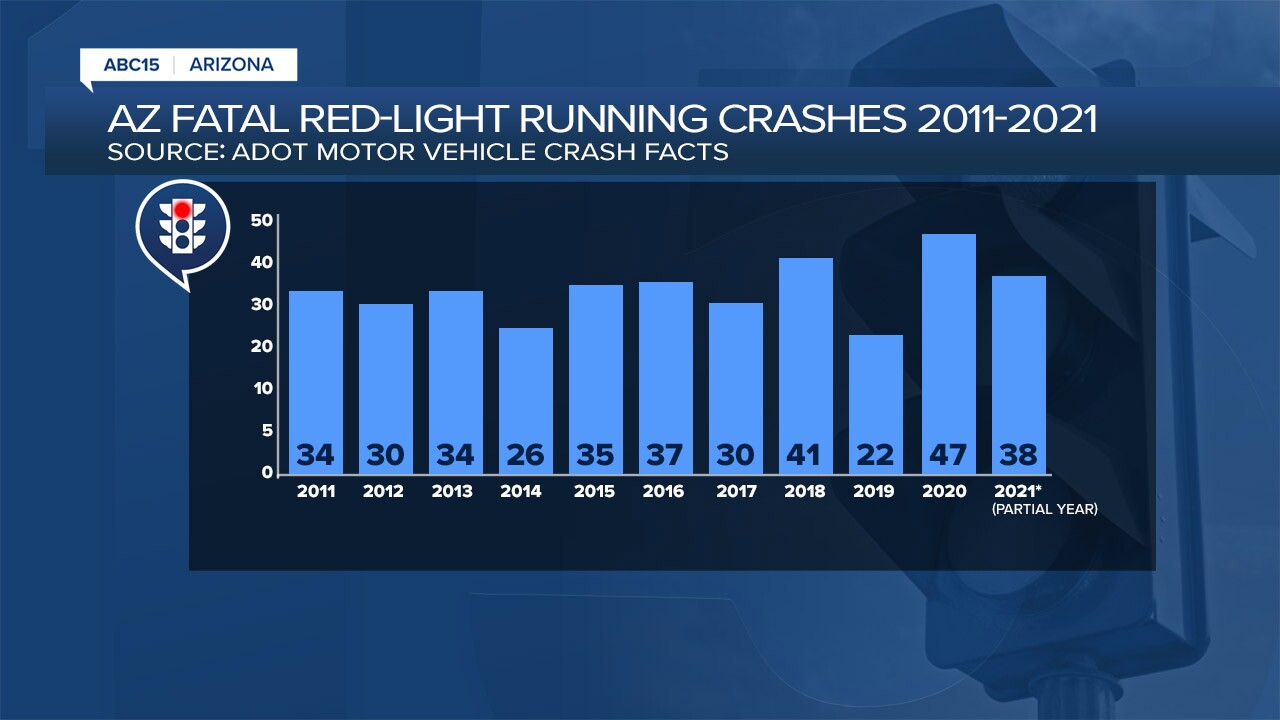The ABC15 Investigators found most large Arizona cities time their yellow lights shorter than the national traffic engineering standard, even as our state has the worst death rate for red-light running crashes in the nation.
A 2019 AAA Foundation study found Arizona had the most deaths, per capita, from red-light running crashes in the nation.
An ABC15 analysis of crash data from the Arizona Department of Transportation found 374 fatal crashes since 2011. The highest number of crashes, 47, happened in 2020. There were at least 38 so far in 2021.

Source: ABC15 Analysis of ADOT data
Pamela Hesselbacher died in November 2016 after a red-light runner hit her in the crosswalk at Ray Road and College Avenue in Chandler. Pamela’s two young children, one in a stroller and one on a bike, were injured in the crash.
“She was doing all the right things: crossing the street, pushing the button, waiting for the signals to change,” said Jody Kieran, Hesselbacher’s mom.
Kieran said her daughter expected others to do the right thing too, like slowing down on yellow and stopping on red.

“A lot of people think that it means that you have to be Mario Andretti and punch, punch the gas and try and make it through, and that thinking has to change,” Kieran said.
Red-light running drivers are of particular concern for traffic safety experts because they tend to cause so much damage and injury.
“When they blast through that red light, another car is coming the opposite direction,” explained attorney Marc Lamber, who specializes in traffic, personal injury, and wrongful death cases. “It's a right angle - a T-bone hit - which tends to be really bad from an injury severity standpoint.”
Longer Yellow Lights Can Save Lives
Over the years, studies have looked at whether longer-duration yellow lights could prevent some red-light running crashes.
Extending yellow lights will save lives,” said Shelia Dunn, a spokeswoman for the National Motorist Association.
An Insurance Institute for Highway Safety study in Philidelphia found red-light running decreased nearly 40 percent at intersections where the yellow light duration was increased by one second.
Other studies show increasing yellow timing to meet guidelines set by the Institute of Transportation Engineers can significantly decrease the frequency of red-light violations and reduce the risk of crashes.
ITE is considered the leading national expert on traffic signal timing, and the organization created a formula for minimum timing of yellow lights based on reaction time, road grade, deceleration, and vehicle speed. ITE currently recommends local traffic engineers calculate the vehicle speed by using the actual speed of cars approaching the intersection, not necessarily the speed limit. ITE recommends if the actual speed is unavailable, localities should use the posted speed and add seven miles per hour.
In a 45-mph zone, the ITE yellow light formula would use 52 mph as the approximate speed.
The ABC15 Investigators collected data from the Valley's largest cities and looked at yellow light timing at 30, 35, 40, and 45 mph speed limits.
ABC15’s analysis found nine of the 10 largest Valley cities had shorter yellow lights than what ITE recommends, at least at some speeds. Peoria was the only city meeting ITE guidelines. Phoenix and Surprise had the shortest overall yellow-light durations.
Phoenix has a 4.3 second yellow light on 45 mph roads. Peoria has yellow lights that are a half-second longer at 4.8 seconds.

“I'm disappointed,” said Chuck Farmer with the Insurance Institute for Highway Safety, “They may be having a shorter yellow because they want to get more traffic through.”
Farmer describes traffic signal timing as a trade-off between traffic flow and safety.
“It should be very straightforward but seems like it's somewhat political, or people just aren't thinking,” Dunn said.
Phoenix traffic safety officials declined an interview with ABC15 for this story. A spokesman issued this statement:
The City of Phoenix has historically followed the ITE guidance for yellow light timing, and currently follows the recommendation that was in place prior to 2020. The 2020 ITE recommendation was based on a different validation process than had been used previously and multiple state departments of transportation nationwide are reviewing that inconsistency.
Longer yellows can't prevent all red-light running. Sometimes the at-fault driver is just too drunk or distracted.
Pam Hesselbacher’s mom believes giving extra time for traffic to stop is worth it.
“A couple of seconds of you waiting would have saved my daughter's life or somebody else's life,” Kieran said.
It’s still unclear why many Valley cities are not using ITE’s longer yellow light timing guidelines. However, ABC15’s four-month investigation found some cities use the Arizona Department of Transportation’s standards for yellow light timing. ADOT does not use the +7 mph method. Instead, the department uses only posted speed in its formula.
Late Monday, ADOT responded to our request for comment with the following statement:
Driver behavior, including speeding and impaired driving, is the leading cause of most crashes - red light running included - on state and local roadways. ADOT’s traffic control infrastructure meets or exceeds national safety standards. ADOT conducts safety-based reviews and uses sound engineering judgment to consider changes, if warranted, at signals or to signs and pavement markings in response to driver behavior issues. Changes would not be solely based on a single year’s crash numbers.
ADOT is conducting a review of the recommended ITE guidelines related to traffic signal timing. Current-condition data is being collected at a variety of intersections. That review will help determine if the recommendations proposed by ITE justify proceeding to “before and after” field testing at selected intersections in the next year.
Got a news tip? Email ABC15 Investigator Melissa Blasius at Melissa.Blasius@abc15.com and follow her on Twitter and Facebook.





